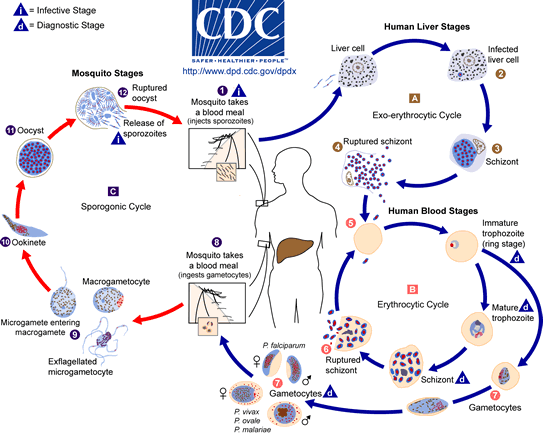
This web page was produced as an assignment for an undergraduate course at Davidson College.
Life Cycle
The malaria parasite is a multi-stage protozoan with a complex life cycle requiring an insect vector and a human host. There are three phases in its life cycle: the pre-erythrocitic cycle, the erythrocytic cycle, and the sporogonic cycle.
 |
| Overview of Plasmodium's life cycle. CDC 2006. |
Pre-erythrocytic Stage
Plasmodium lives in the gut and salivary glands of the female Anopheles mosquitoes. When an infected mosquito takes a blood meal, she injects saliva that contains the parasite in its infectious sporozoite form into the human bloodstream. From the bloodstream, the sporozoites invade hepatocytes. Circumsporozoite protein (CS), the principal protein on the surface of sporozoites, binds to basolateral domain of the hepatocytes, and then other proteins, including sporozoite surface protein (SSP2), initiate hepatocyte invasion. Studies indicate that the bloodstream is free of sporozoites within 60 minutes (NIH, 2007; Khan and Lai 1999).
During the next one to two weeks, the sporozoites undergo asexual reproduction and develop into schizonts, structures that can contain thousands of merozoites (NIAID, 2002). It is estimated that each Plasmodium falciparum sporozoite can have up to 40,000 merozoites. During this period of maturation, no illness is caused by Plasmodium (Khan and Lai, 1999).
Erythrocytic Cycle
Once a liver schizont has matured, it ruptures, and the merozoites spill into the bloodstream. Within 1-2 minutes, each merozoite has invaded an erythrocyte. Once in the erythrocyte, the merozoite consumes hemoglobin, the oxygen-carrying structure in the erythrocytes, to use for energy, at which point it becomes known as a trophozoite. It uses this energy to form schizonts and begin another round of asexual amplification, producing up to 36 merozoites per schizont (NIH, 2007). When this schizont ruptures, the merozoites are released into the bloodstream once again and infect other red blood cells.
This cycle of infection, multiplication, and bursting continues until it is brought under control by the immune system or by antimalarial drugs. These erythrocitic merozoites are responsible for the clinical manifestations of malaria (NIH, 2007).
Sporogonic Cycle
A few of the blood-stage merozoites do not develop into schizonts, but rather differentiate into male and female gametocytes, which can be ingested by a mosquito during a blood meal. Fertilization occurs in the mosquito’s stomach, producing zygotes. The zygotes develop into motile, elongated ookinetes, which penetrate the mosquito’s mid-gut wall and mature into oocysts. The oocysts grow, divide, and rupture, releasing sporozoites that travel to the mosquito’s salivary glands. The infectious cycle can repeat once the mosquito feeds on another human host (CDC 2006).
The Wellcome Trust's animation of P. falciparum infection
Works Cited
Khan, Nasser and Andrew Lai. “The malaria website: pathology/immune response.” 1999. Biology Department, Brown University. <http://www.brown.edu/Courses/Bio_160/Projects1999/malaria/ldpg.html> Accessed 2007 Feb 25.
National Institutes of Health (NIH). 2007 Feb. “Understanding malaria: fighting an ancient scourge.” U.S. Department of Health and Human Services. <http://www.niaid.nih.gov/publications/malaria/pdf/malaria.pdf>. Accessed 2007 May 3.
Centers for Disease Control (CDC). 2006. “Schema of the life cycle of malaria.” <http://www.cdc.gov/malaria/biology/life_cycle.htm>. Accessed 2007 Feb 9.
Questions? Email ruturakhia@davidson.edu
Davidson College Home